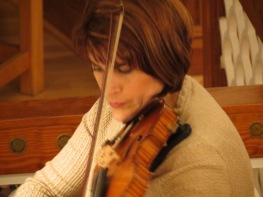Music Tells Your Video Story, Too

Hey, here I am playing a violin solo in concert!
Most people focus on visuals when working on video storytelling. It’s a natural instinct. Our world is dominated by visuals-rich social media like SnapChat, Instagram, Facebook and Twitter and more. But the audio track for your video is a critical part of your storytelling toolkit. There are two options for music for video: original scoring and licensed stock music.
Original Music Scoring
A professionally composed score-to-picture, which usually includes at least one set of revisions, will run you a minimum of $2,500-3,500 for a 30-second spot, at least $3,500 for a 5 minute video, and upwards of $8,000 for a half-hour documentary. Name-brand musicians can cost you much more. Fees for session musicians (a band or orchestra) are extra. And don’t think about using your friend who plays an instrument–session players are pros who read every type of music imaginable and have perfect intonation on the first take. Many composers can do without live musicians for smaller-budget projects by using good quality sampled sounds. And most composers will negotiate on fee based on how busy they are right now, how quickly they think they can do your project, or simply because you are offering an interesting challenge or a distribution exposure that interests them.
Before you give up on an original score because of cost, remember that this music works PERFECTLY with every visual on screen and creates EXACTLY the kinds of moods and transitions you need from scene to scene. Trying to find stock music that fits the bill requires hours of your time to audition tracks, and then more hours of editing time to mesh them together and finesse endings that are usually not right for your visuals. So for many projects, an original score is well worth it.
What’s the Original Score Workflow?
- Cut Scenes to “Temp Tracks”. This means finding music–even pop songs you can’t license, since you are going to replace them–that are the right tempo and mood to edit your scenes. I might use three or four temp tracks in any given short form project. Or nine or 10 for a half-hour show. This would be a mess to edit, but we will simply replace all of these with our custom score (a process called “laying back”) once the original music score is finished.
- Get “Picture Lock”. Before you can score, you need a 100% approved video, with all the images and voices and “sound-ups” (where you hear what someone is saying during a piece of background footage) in fixed locations in your video timeline. Any slippage by even a few frames will mean adjusting the score with the composer.
- Output Video to Composer’s Specs. Most composers want a video file that has a visible time-code window, so they can be sure they are achieving perfect synchronicity with your show. Depending on the type of software they use, a composer will request a particular type of video file they like to work with.
- Talk! You’ll want to discuss with your composer what goals you are trying to achieve with your film or spot, and what different moods you want to create with various scenes. If I have a particular genre or style of instrumentation that I want, I will also share temp tracks as examples.
An experienced composer may be able to write your music to picture for a very short film in a single day. Depending on how I’ve negotiated the fee, we’ll usually go through at least one round of tweaks before we get to a final score and go to lay back.
Using Stock Music
There are many online sources for good stock music, which can range in cost from $35 per cut to $500 per cut, depending on the source and the kind of distribution license you need. Be careful to purchase a license for online distribution, even if you have other ways of getting your video out, because YouTube now regularly pulls down videos for lacking the proper music license.
Premium music libraries that offer better-sounding orchestrations, a wide range of musical styles, and different lengths and underscore versions of tracks include www.apmmusic.com www.killertracks.com and www.audionetwork.com . A great feature of Audio Network for me as a musician is that they list the key the music is in. That allows me to search for a related key for a transition from one piece to another, rather than having an ugly transition between two keys that don’t sound good together, or are identical. There are also lower-cost libraries such as www.premiumbeat.com and www.audiojungle.net which have plenty of great tracks to choose from. My only issue with their music is that the mixes are often muddy and require additional audio adjustment work in a sound studio if you plan to use them in a large room for live event playback.
Why Music Matters
Whether you go with stock music or scored music, you need to create the right mood for your message. I recently had a client send me a series of cute kid testimonials in a series of promo videos that they had shot. Something in the rough-cuts of these video just wasn’t working. They wanted me to help re-arrange the soundbites for a more compelling story. But the first thing I did was send them the same cuts but with new soundtracks for each. Presto! You see, their corporate music track was completely undermining the quirky, real-world comments of the kids. With just a little bit of re-tooling, I had a much happier client, and a better video story.
Amy DeLouise is a video director/producer who is passionate about great music. Her new book The Producer’s Playbook: Real People on Camera comes out this spring (Focal Press/Routledge).





Leave a Reply
Want to join the discussion?Feel free to contribute!